
The Narrow Gauge Railway Museum is a purpose-built museum dedicated to narrow-gauge railways situated at the Tywyn Wharf station of the Talyllyn Railway in Tywyn, Gwynedd, Wales.

The Hunslet Engine Company is a locomotive-building company, founded in 1864 in Hunslet, England. It manufactured steam locomotives for over 100 years and currently manufactures diesel shunting locomotives. The company is part of Ed Murray & Sons.

The Bala Lake Railway is a narrow-gauge railway along the southern shore of Bala Lake in Gwynedd, North Wales. The line, which is 4+1⁄2 miles (7.2 km) long, is built on a section of the former standard-gauge Ruabon–Barmouth GWR route that closed in 1965. Another section of the former permanent way is used by the Llangollen Railway. The Bala Lake Railway, which runs on 600 mm -gauge preserved rolling stock, is a member of the Great Little Trains of Wales.
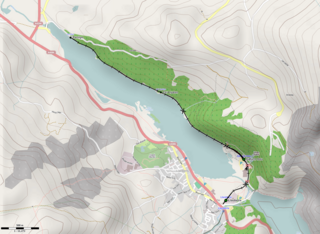
The Llanberis Lake Railway is a 1 ft 11+1⁄2 in narrow gauge heritage railway that runs for 2.5 miles (4 km) along the northern shore of Llyn Padarn in north Wales in the Snowdonia National Park. The starting point is the village of Llanberis at the eastern end of the lake, with the western terminus at Pen Llyn in the Padarn Country Park. The return journey takes around 60 minutes.

The Penrhyn Quarry Railway was a narrow gauge railway in Caernarfonshire, Wales. It served the Penrhyn quarry near Bethesda, taking their slate produce to Port Penrhyn, near Bangor. The railway was around six miles (9.7 km) long and used a gauge of 1 ft 10+3⁄4 in.

The National Slate Museum is located at Gilfach Ddu, the 19th-century workshops of the now disused Dinorwic quarry, within the Padarn Country Park, Llanberis, Gwynedd. The museum is dedicated to the preservation and display of relicts of the Slate industry in Wales.

The Padarn Railway was a narrow gauge railway in North Wales, built to the unusual gauge of 4 ft. It carried slate seven miles (11 km) from Dinorwic Quarry to Port Dinorwic. The line opened on 3 March 1843, replacing the Dinorwic Railway. It initially used horses, but was converted to steam haulage on 23 November 1848. The railway was formally titled the Dinorwic Quarries Railway or Dinorwic Quarry Railway, but informally "Padarn Railway" was widely used.
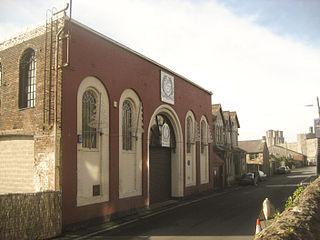
De Winton & Co (1854–1901) were engineers in Caernarfon, Wales. They built, amongst other things, vertical boilered narrow gauge locomotives for use in Welsh slate mines and other industrial settings. At least six De Winton locomotives have been preserved. But these quarry tramway locomotives, for which in the 21st century they are largely remembered, were just a small part of this company's engineering output.
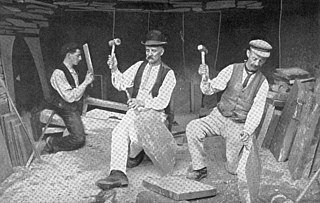
The existence of a slate industry in Wales is attested since the Roman period, when slate was used to roof the fort at Segontium, now Caernarfon. The slate industry grew slowly until the early 18th century, then rapidly during the Industrial Revolution in Wales until the late 19th century, at which time the most important slate producing areas were in northwest Wales. These sites included the Penrhyn Quarry near Bethesda, the Dinorwic Quarry near Llanberis, the Nantlle Valley quarries, and Blaenau Ffestiniog, where the slate was mined rather than quarried. Penrhyn and Dinorwig were the two largest slate quarries in the world, and the Oakeley mine at Blaenau Ffestiniog was the largest slate mine in the world. Slate is mainly used for roofing, but is also produced as thicker slab for a variety of uses including flooring, worktops and headstones.
The Dinorwic Railway was an early 2 ft narrow gauge industrial railway connecting the slate quarry at Dinorwic in Caernarvonshire with the coastal port at Y Felinheli. The line is sometimes referred to as the Dinorwic Tramroad or the Dinorwic Tramway.

Dinorwic quarry is a large former slate quarry, now home to the Welsh National Slate Museum, located between the villages of Llanberis and Dinorwig in Wales. At its height at the turn of the century, it was the second largest slate quarry in Wales, after the neighbouring Penrhyn quarry near Bethesda. Dinorwic covered 700 acres (283 ha) consisting of two main quarry sections with 20 galleries in each. Extensive internal tramway systems connected the quarries using inclines to transport slate between galleries. Since its closure in 1969, the quarry has become the site of the National Slate Museum, a regular film location, and an extreme rock climbing destination.

The Eigiau Tramway might refer to the Eigiau Quarry Tramway or to the Eigiau Reservoir Tramway.

Fire Queen is an early steam locomotive built by A. Horlock and Co in 1848 for the Padarn Railway. It is the only surviving locomotive from that railway, and it is preserved at the Penrhyn Castle Railway Museum.
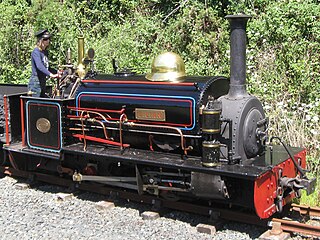
The Penrhyn Port Class was a class of three narrow gauge steam locomotives built for the Penrhyn Quarry Railway (PQR). These locomotives were built by the Hunslet Engine Company between 1883 and 1885 and supplied specifically to work at Port Penrhyn near Bangor, north Wales. They were a variant of the standard Dinorwic Alice Class design.

The Dinorwic Alice Class is a class of eleven narrow-gauge 0-4-0ST steam locomotives built specifically for the Dinorwic Slate Quarry. These locomotives were built by the Hunslet Engine Company between 1886 and 1904, and were designed and supplied specifically to work the many galleries of the quarry at Llanberis, North Wales.

Graig Ddu quarry is a disused slate quarry near Blaenau Ffestiniog, in Gwynedd, North Wales. Although output was only about 3,000 tons a year, it reputedly has 36 saw tables and the same number of dressing machines on site. As with others in the area, the quarry suffered from a lack of water, resulting in the siting of the mill some distance away, at a lower level.

Llanberis (LLR) railway station is the southern terminus of the Llanberis Lake Railway (LLR), located in Llanberis, Gwynedd, Wales. The line and station primarily serve tourists and railway enthusiasts.

Gilfach Ddu (LLR) railway station is an intermediate station on the Llanberis Lake Railway (LLR), located in Llanberis, Gwynedd, Wales.

Cei Llydan is an intermediate railway station on the Llanberis Lake Railway (LLR), located in Llanberis, Gwynedd, Wales.
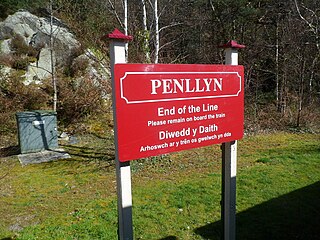
Penllyn (LLR) railway station is the northern terminus of the Llanberis Lake Railway (LLR), located near Llanberis, Gwynedd, Wales. The station has no platforms and passengers are not allowed to board or alight.




















